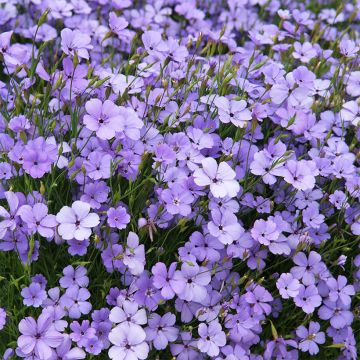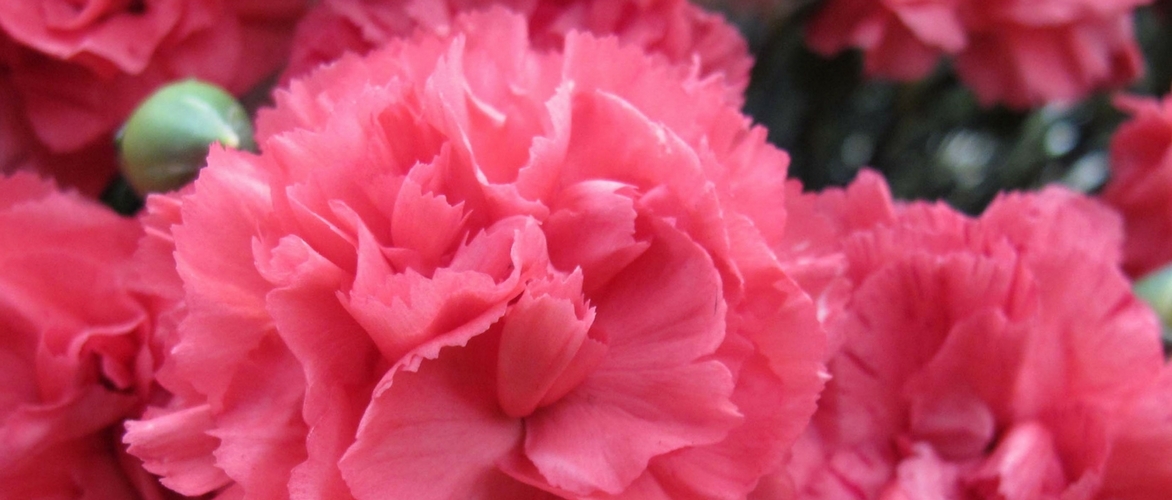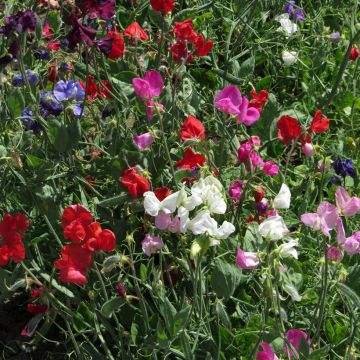

Elegance Pink F1 Carnation - Dianthus seeds
Elegance Pink F1 Carnation - Dianthus seeds
Dianthus Elegance Pink F1
Pink, Pot Carnation
Little flowering
Eugenie L., 20/09/2020
Special offer!
Receive a €20 voucher for any order over €90 (excluding delivery costs, credit notes, and plastic-free options)!
1- Add your favorite plants to your cart.
2- Once you have reached €90, confirm your order (you can even choose the delivery date!).
3- As soon as your order is shipped, you will receive an email containing your voucher code, valid for 3 months (90 days).
Your voucher is unique and can only be used once, for any order with a minimum value of €20, excluding delivery costs.
Can be combined with other current offers, non-divisible and non-refundable.
Why not try an alternative variety in stock?
View all →This plant carries a 6 months recovery warranty
More information
We guarantee the quality of our plants for a full growing cycle, and will replace at our expense any plant that fails to recover under normal climatic and planting conditions.
Would this plant suit my garden?
Set up your Plantfit profile →
Description
The Dianthus Elegance Pink F1 is part of a new series of selected hybrid carnations known for their well-branched growth and endless flowering in vibrant shades, gently scented. The flowers of this 'Pink' variety are frilly and display a beautiful gradient of pink, ranging from bright red-pink to candy pink depending on the age of the flower. It is a generous and undemanding annual plant that withstands heat well and does not require staking. Stunning in borders and sunny containers, its flowers are perfect for bouquets.
The 'Elegance Pink F1' carnation belongs to the caryophyllaceae family. It is a recent cultivar, recently recognized at Fleuroselect, for its performance in the garden. It is derived, among others, from D. chinensis, an annual plant native to a large part of China. The growth of this short-lived perennial carnation is very rapid, so the plant germinates and flowers within a few months. Its mature size will reach about 45 - 50 cm (17.7 - 19.7 in) in height when in bloom (up to 60 cm (23.6 in) in fertile soil), with a spread of 30 cm (11.8 in) or more. This carnation forms a lovely, bushy, and branched habit. Its long, narrow, pointed, linear leaves are bluish-green and arranged in opposite pairs on slender but sturdy stems. The flowering begins in June and continues until September-October if the soil is not too dry. The plant is then covered continuously with beautiful double flowers, with strongly fringed petals, about 4 cm (1.6 in) wide. They are lightly scented and usually borne singly at the top of the stems.
Plant the Elegance Pink F1 carnation in a sunny spot, either in a border or in a pot on the terrace or balcony, where it can thrive. Before planting, in heavy or clayey soils, add some gravel and coarse sand to facilitate water drainage. The Elegance Pink F1 carnation pairs nicely with catmints, geraniums, perennial salvias, creeping baby's breath, or agastaches, for example. Its combination with small ornamental grasses (Stipa, Pennisetum, Carex) and ornamental onions (Pinball Wizard, Purple Sensation) is also very successful.
The generic name Dianthus comes from the Greek 'dios' meaning 'Jupiter or divine' and 'anthos' meaning 'flower'. These dianthus, or 'divine flowers,' were named as such by Theophrastus due to their sweet fragrance and beauty.
Flowering
Foliage
Plant habit
Botanical data
Dianthus
Elegance Pink F1
Caryophyllaceae
Pink, Pot Carnation
Cultivar or hybrid
Other Dianthus seeds
View all →Planting and care
Sow annual carnations from February to April.
Sow on the surface of a light and moist compost in pots or trays and cover with a thin pinch of compost or vermiculite. Keep at a temperature between 18-20 ° C. After sowing, keep in the light as this promotes germination. Keep the compost surface moist but not waterlogged; germination usually takes 14-30 days.
Transplant the plants large enough to handle into 8 cm (3.1 in) pots or trays. Acclimatize them gradually to a cooler environment for a few weeks before transplanting outdoors once the risk of frost has passed. Space the plants 30 cm (11.8 in) apart.
Cultivation:
Plant Elegance Pink F1 Carnation in ordinary, well-drained, humus-rich soil, gravelly, sandy or chalky, especially well-drained. A soil rich in gravel and compost yields good results. This plant prefers a very sunny exposure. Water in case of prolonged drought. Regularly remove faded flowers to encourage flowering and prolong its lifespan. In poor soil, it will be useful to apply a balanced fertilizer in March. This carnation does not tolerate competition from invasive plants, which, when placed nearby, can make it disappear by imposing too much shade.
Sowing period
Intended location
Planting & care advice
-
, onOrder confirmed
Reply from on Promesse de fleurs
Similar products
Haven't found what you were looking for?
Hardiness is the lowest winter temperature a plant can endure without suffering serious damage or even dying. However, hardiness is affected by location (a sheltered area, such as a patio), protection (winter cover) and soil type (hardiness is improved by well-drained soil).

Photo Sharing Terms & Conditions
In order to encourage gardeners to interact and share their experiences, Promesse de fleurs offers various media enabling content to be uploaded onto its Site - in particular via the ‘Photo sharing’ module.
The User agrees to refrain from:
- Posting any content that is illegal, prejudicial, insulting, racist, inciteful to hatred, revisionist, contrary to public decency, that infringes on privacy or on the privacy rights of third parties, in particular the publicity rights of persons and goods, intellectual property rights, or the right to privacy.
- Submitting content on behalf of a third party;
- Impersonate the identity of a third party and/or publish any personal information about a third party;
In general, the User undertakes to refrain from any unethical behaviour.
All Content (in particular text, comments, files, images, photos, videos, creative works, etc.), which may be subject to property or intellectual property rights, image or other private rights, shall remain the property of the User, subject to the limited rights granted by the terms of the licence granted by Promesse de fleurs as stated below. Users are at liberty to publish or not to publish such Content on the Site, notably via the ‘Photo Sharing’ facility, and accept that this Content shall be made public and freely accessible, notably on the Internet.
Users further acknowledge, undertake to have ,and guarantee that they hold all necessary rights and permissions to publish such material on the Site, in particular with regard to the legislation in force pertaining to any privacy, property, intellectual property, image, or contractual rights, or rights of any other nature. By publishing such Content on the Site, Users acknowledge accepting full liability as publishers of the Content within the meaning of the law, and grant Promesse de fleurs, free of charge, an inclusive, worldwide licence for the said Content for the entire duration of its publication, including all reproduction, representation, up/downloading, displaying, performing, transmission, and storage rights.
Users also grant permission for their name to be linked to the Content and accept that this link may not always be made available.
By engaging in posting material, Users consent to their Content becoming automatically accessible on the Internet, in particular on other sites and/or blogs and/or web pages of the Promesse de fleurs site, including in particular social pages and the Promesse de fleurs catalogue.
Users may secure the removal of entrusted content free of charge by issuing a simple request via our contact form.
The flowering period indicated on our website applies to countries and regions located in USDA zone 8 (France, the United Kingdom, Ireland, the Netherlands, etc.)
It will vary according to where you live:
- In zones 9 to 10 (Italy, Spain, Greece, etc.), flowering will occur about 2 to 4 weeks earlier.
- In zones 6 to 7 (Germany, Poland, Slovenia, and lower mountainous regions), flowering will be delayed by 2 to 3 weeks.
- In zone 5 (Central Europe, Scandinavia), blooming will be delayed by 3 to 5 weeks.
In temperate climates, pruning of spring-flowering shrubs (forsythia, spireas, etc.) should be done just after flowering.
Pruning of summer-flowering shrubs (Indian Lilac, Perovskia, etc.) can be done in winter or spring.
In cold regions as well as with frost-sensitive plants, avoid pruning too early when severe frosts may still occur.
The planting period indicated on our website applies to countries and regions located in USDA zone 8 (France, United Kingdom, Ireland, Netherlands).
It will vary according to where you live:
- In Mediterranean zones (Marseille, Madrid, Milan, etc.), autumn and winter are the best planting periods.
- In continental zones (Strasbourg, Munich, Vienna, etc.), delay planting by 2 to 3 weeks in spring and bring it forward by 2 to 4 weeks in autumn.
- In mountainous regions (the Alps, Pyrenees, Carpathians, etc.), it is best to plant in late spring (May-June) or late summer (August-September).
The harvesting period indicated on our website applies to countries and regions in USDA zone 8 (France, England, Ireland, the Netherlands).
In colder areas (Scandinavia, Poland, Austria...) fruit and vegetable harvests are likely to be delayed by 3-4 weeks.
In warmer areas (Italy, Spain, Greece, etc.), harvesting will probably take place earlier, depending on weather conditions.
The sowing periods indicated on our website apply to countries and regions within USDA Zone 8 (France, UK, Ireland, Netherlands).
In colder areas (Scandinavia, Poland, Austria...), delay any outdoor sowing by 3-4 weeks, or sow under glass.
In warmer climes (Italy, Spain, Greece, etc.), bring outdoor sowing forward by a few weeks.

































































